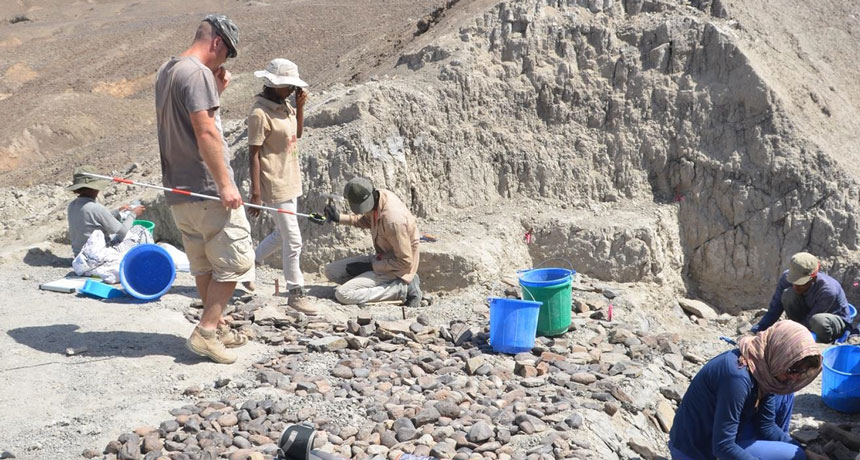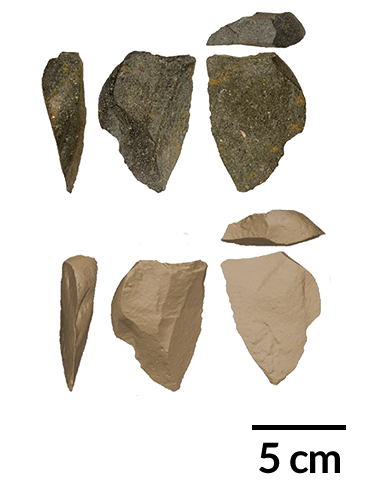Hominids may have been cutting-edge tool makers 2.6 million years ago
Contested finds point to a sharp shift in toolmaking by early members of the Homo genus

TOOL TIME Researchers study sediments in Ethiopia where sharp-edged stone tools dating to around 2.6 million years ago were found. Rocks placed over excavated areas protected fragile sediment.
Erin Dimaggio
Discoveries in East Africa of what may be the oldest expertly sharpened stone implements suggest that early members of the human genus, Homo, invented these tools by around 2.6 million years ago, researchers say. But their conclusions are controversial.
New finds at a site in Ethiopia called Ledi-Geraru fit a scenario in which various early Homo groups devised ways to sharpen handheld stones, assert archaeologist David Braun of George Washington University in Washington, D.C., and his colleagues. Ledi-Geraru artifacts date to between 2.58 million and 2.61 million years ago, the team reports online June 3 in the Proceedings of the National Academy of Sciences.
Another team previously had unearthed sharpened stones that were 2.55 million to 2.58 million years old at Gona, a nearby Ethiopian site (SN: 4/17/04, p. 254). Until now, those were the oldest examples of cutting and digging devices with systematically sharpened edges. Archaeologists refer to these types of artifacts as Oldowan tools because the first examples were found at East Africa’s Olduvai Gorge.
Age estimates for Ledi-Geraru artifacts were determined by where they were found, between a dated layer of volcanic ash and sediment preserving a known reversal of Earth’s magnetic field. Stone tools at Ledi-Geraru “are probably at least 50,000 years older, but could be up to 100,000 years older than Gona artifacts,” Braun says. His team recovered 300 stone artifacts, including sharp-edged rocks and larger rocks from which those implements were struck. Those finds were strewn among 330 fossilized bones of nonhuman animals.
Older stone tools have been discovered. For instance, large stone implements found in Kenya at a site called Lomekwi 3, many perhaps best suited for pounding objects, may date to 3.3 million years ago (SN: 6/13/15, p. 6). Contested evidence, based on possible stone-tool incisions on two 3.4 million-year-old animal bones, suggests that Australopithecus afarensis, ancient hominids best known for Lucy’s partial skeleton, butchered animals before the Homo genus appeared (SN: 9/11/10, p. 8). And present-day chimps and monkeys crack open nuts with stones, a sign that such behavior extends far back in primate evolution (SN: 11/26/16, p. 16).
But the Ledi-Geraru artifacts indicate that Homo, which possibly originated around 2.8 million years ago based on a jaw already found at Ledi-Geraru (SN: 4/4/15, p. 8), took stone-tool making to a new level characterized by skilled edge sharpening, Braun’s group argues.
Archaeologist Ignacio de la Torre of University College London, who did not participate in the new study, agrees. “The association of Oldowan tools with early Homo may be best explained by shifts in diet and access to animal meat through scavenging,” he says.
Animal bones unearthed with the Ledi-Geraru artifacts came from creatures such as gazelles and giraffes that would have inhabited open grasslands with few trees, Braun’s team says. That landscape likely presented frequent scavenging opportunities, the researchers suspect. Lucy’s species would have spied fewer fresh animal carcasses, they contend, because the same part of East Africa featured shrubs with occasional stands of trees and forested areas during her time period.
An ability to cut meat and other food with stone tools may have influenced a transition to smaller teeth observed in early Homo specimens, Braun’s group holds.
No stone tools dating to between 3.3 million and 2.6 million years ago have been found, so it’s unclear if Ledi-Geraru artifacts represented a rapid change in toolmaking or an elaboration of earlier techniques, says archaeologist Sonia Harmand of Stony Brook University in New York. Sharp-edged flakes struck from larger rocks have been found at Kenya’s Lomekwi 3, so precursors of Oldowan techniques might have started developing as early as 3.3 million years ago, says Harmand, who directed Lomekwi 3 excavations.
Other researchers doubt both Braun’s and Harmand’s conclusions. Ledi-Geraru discoveries add to an increasingly confusing picture of early stone-tool making, says archaeologist Manuel Domínguez-Rodrigo of Complutense University in Madrid. Until a detailed analysis of sediment formation at the Ledi-Geraru site is published, he is skeptical of the claim that the newly discovered artifacts were found where they were originally deposited or are as old as reported. Similarly, Domínguez-Rodrigo suspects that Harmand’s Lomekwi 3 artifacts originally lay in much younger sediment before erosion and water moved them down a slope to 3.3 million-year-old sediment. And animal trampling likely created the reported incisions on animal bones from Lucy’s time, he argues.
Ledi-Geraru artifacts were also found on a slope where they could originally have lain in sediment from after 2.6 million years ago, says archaeologist Yonatan Sahle of the University of Tübingen in Germany. Sahle participated in previous fieldwork at Ledi-Geraru with Braun’s group, but isn’t part of the new paper. It’s “simply unwarranted” to tag stone tools excavated at Ledi-Geraru as the earliest Oldowan specimens without a more thorough sediment analysis, Sahle contends. Even the evolutionary identity and age of the Ledi-Geraru jaw initially assigned to Homo are up for grabs, he says.
Microscopic study of Ledi-Geraru sediment indicates that stone artifacts were dropped at the edge of a lake and quickly covered by earth that held the finds in their original positions, Braun says.
For now, scientists’ clashing positions on the reliability and implications of ancient toolmaking evidence also appear held in place, if not etched in stone.








